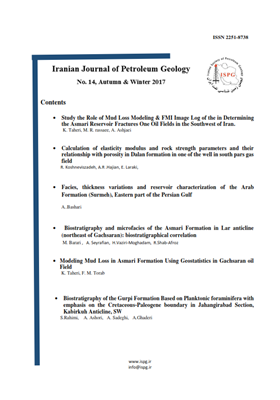Study the role of drilling mud loss modeling and FMI log in determining Asmari reservoir fractures in one of the oil fields in Southwest Iran
Subject Areas : Petroleum Reservoir Geology
Kioumars Taheri
1
![]() ,
Mohammad Reza Rasaei
2
,
Abbas Ashjaei
3
,
Mohammad Reza Rasaei
2
,
Abbas Ashjaei
3
1 - M.Sc. in Petroleum Engineering Exploration, Department of Mining and Metallurgical Engineering, Yazd University, Yazd, Iran
2 - Associate Professor, Institute of Petroleum Engineering, School of Chemical Engineering, College of Engineering, University of Tehran, Tehran, Iran
3 - Head of Design and Planning, Manager Assistance -Exploitation Geological, National Iranian South Oil Fields Company, Ahwaz, Iran
Keywords: Fractures, Asmari Reservoir, FMI Image Log, Porosity Distribution, Mud Loss Map ,
Abstract :
Understanding of oil and gas reservoirs is of great help in maximizing hydrocarbon recovery. In the study of the characteristics of oil structures, the study of fractures of reservoir rock in the stages of production and development of the field is very necessary. Nowadays, the use of mud loss modeling and image logs in helping accomplish this task is of great assistance to oil geologists. Since the most of Iran's reservoirs are carbonate kind, investigating and identifying fractures, the degree of fissures opening and porosity distribution in the Asmari reservoir field of study, It is one of the most effective factors in the production of hydrocarbons from this field. One of the best ways to identify and interpret geology in the well, using of the FMI image log is, which can create high quality images from the well. With the help of the images provided, can determine the types of fractures, porosity, the distribution of diagenetic porous spaces and the estimation of permeability trend. In this article, first, structure and Functionality of the FMI image log and then drilling and production problems were evaluated in Asmari reservoir. In the following, the functional role of the log in interpreting and determining the degree of fissures opening, porosity distribution and permeability level in 8 wells in Asmari reservoir, has been evaluated. In this study, identification of Asmari reservoir fractures and how to expand these fractures in the reservoir By using mud loss modeling, interpretation of the FMI image log and the effect of these fractures was on the porosity and permeability of the reservoir. In this study, it has been determined that, fractures identified in wells very good matching with drilling mud loss maps with rock basement faults at the has anticline of the Asmari reservoir.
1. Taheri, K., et al., Correction Investigating the Design of Casing Pipes Using Drilling Data Analysis in Bangestan Wells, One of the Oil Fields in the Southwest of Iran. Journal of Petroleum Geomechanics, 2018. 2(1): p. 41-54
. 2. Taheri, K. and A.H. Morshedy, Three-dimensional Modeling of Mud Loss Zones Using the Improved Gustafson-Kessel Fuzzy Clustering Algorithm (Case Study: One of the South-western Oil Fields). Journal of Petroleum Research, 2017. 27(96-5): p. 82-97
. 3. Taheri, K. and F. Mohammad Torab, Applying Indicator Kriging in Modeling of Regions with Critical Drilling Fluid Loss in Asmari Reservoir in an Oil Field in Southwestern Iran. Journal of Petroleum Research, 2017. 27(96-4): p. 91-104
. 4. Taheri, K., & Torab, F. M. (2017). Modeling Mud Loss in Asmari Formation Using Geostatistics in RMS Software Environment in an Oil Field in Southwestern Iran. Iranian Jurnal of Petroleum Geology, 11(6), 1-10. http://rimag.ricest.ac.ir/fa/Article/33820
. 5. Alizadeh, M., Movahed, Z., Junin, R., Mohsin, R., Alizadeh, M., & Alizadeh, M. (2015). Finding the Drilling Induced Fractures and Borehole Breakouts Using Image Logs. Journal of Advanced Research, 10(1), 9-30
. 6. Taheri, K. (2016). Prediction & Modeling of Mud Circulation Loss Using Geostatistical Methods In Asmari Reservoir, Gachsaran Oil Field, Yazd University, Iran
. 7. Davarpanah, A., Kakoli, M., & Ahmadi, M. (2016). Analysis of Fractured Reservoir Structure by Interpretation of FMI and VSP Logs. J Marine Sci Res Dev 6: 216. doi: 10.4172/2155-9910.1000216 Page 2 of 5 Volume 6• Issue 6• 1000216. Receiver’s correction
. 8. Ezati, M., Soleimani, B., & Moazeni, M. S. (2014). Fracture and horizontal stress analysis of Dalan Formation using FMI image log in one of southwestern Iranian oil wells. Journal of Tethys, 2(1), 1-8
. 9.
Ragan, D. M., & Ragan. (1985). Structural geology. John Wiley & Sons. 10. Riskha, H., Syafri, I., Ismawan, I., & Natasia, N. (2017). Characterization of Basement FRACTURE reservoir in FIELD ‘X’, South Sumatera Basin, based on the analysis of core and Fmi log. Journal of Geoscience, Engineering, Environment, and Technology, 2(2), 155-165
. 11. Khoshbakht, F., Memarian, H., & Mohammadnia, M. (2009). Comparison of Asmari, Pabdeh and Gurpi formation's fractures, derived from image log. Journal of Petroleum Science and Engineering, 67(1-2), 65-74
. 12. Slim, M. I. (2007). Borehole-image log interpretation and 3D facies modeling in the Mesaverde group, Greater Natural Buttes field, Uinta basin, Utah Colorado School of Mines
]. 13.
Nelson, R. (2001). Geologic analysis of naturally fractured reservoirs. Elsevier. 14.
Slatt, R. M. (2006). Stratigraphic reservoir characterization for petroleum geologists, geophysicists, and engineers. Elsevier. 15. Sanaee, R., Shadizadeh, S. R., & Riahi, M. A. (2010). Determination of the stress profile in a deep borehole in a naturally fractured reservoir. International Journal of Rock Mechanics and Mining Sciences, 47(4), 599-605
. 16.
Serra, O. (1989). Formation MicroScanner image interpretation. Schlumberger Educational Services.
17.
Tingay, M., Reinecker, J., & Müller, B. (2008). Borehole breakout and drilling-induced fracture analysis from image logs. World Stress Map Project, 1, 8. 18. Wang, R., Song, H., Tang, H., Wang, Y., Killough, J., & Huang, G. (2016). Analytical modeling of gas production rate in tight channel sand formation and optimization of artificial fracture. SpringerPlus, 5(1), 1-14
. 19. Vatandoust, M., & Farzipour Saein, A. (2017). Prediction of open fractures in the Asmari Formation using geometrical analysis: Aghajari Anticline, Dezful Embayment, SW Iran. Journal of Petroleum Geology, 40(4), 413-426
.


